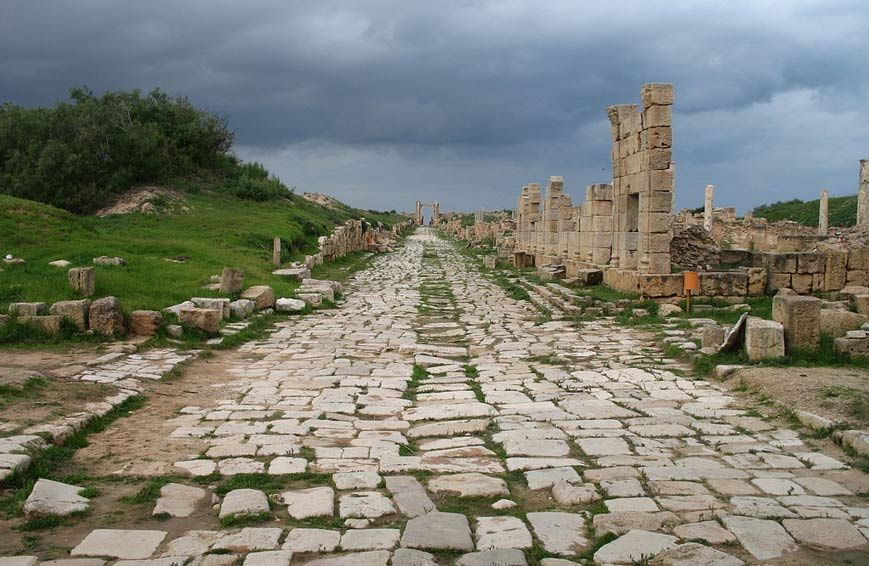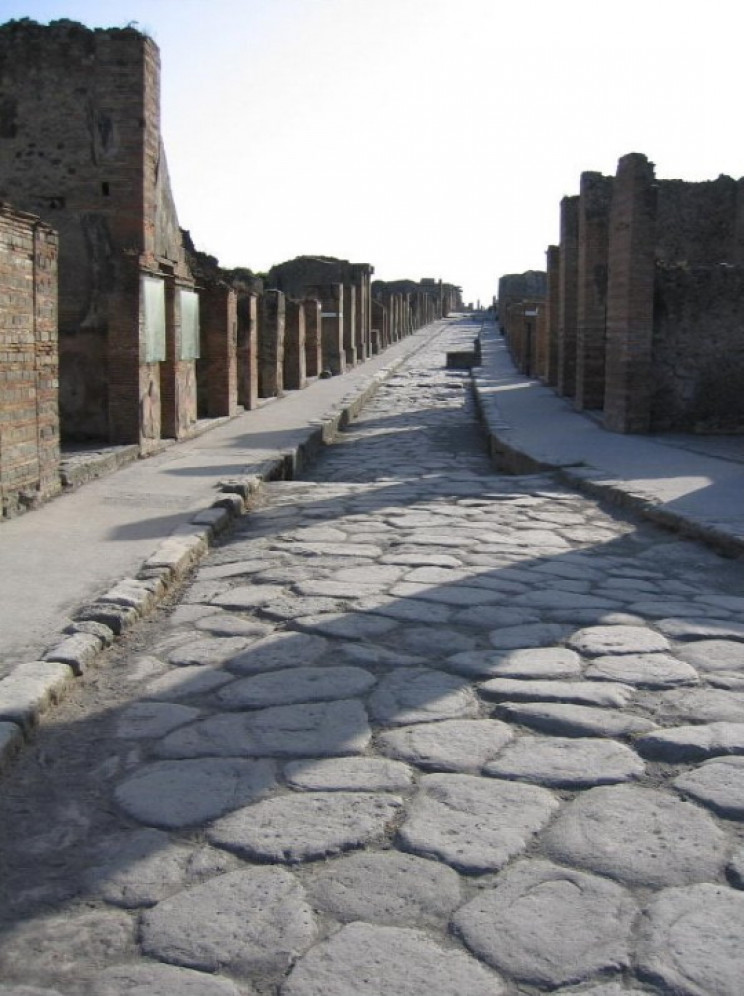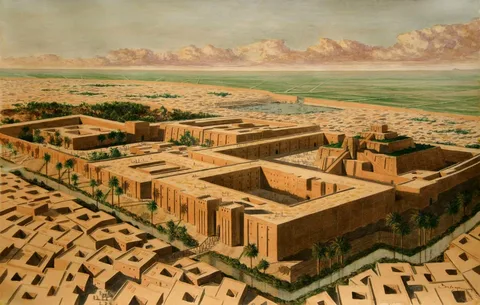Preparation and Planning
Surveying the Route
The construction of ancient Roman roads was a complex process that required careful planning, precise engineering, and immense labor. The goal of surveying the route was to ensure that the road was built on a straight line, with a slight camber in the middle to facilitate water drainage and prevent erosion.
Before any excavation began, surveyors would conduct a thorough reconnaissance of the proposed route. They would map out the terrain, noting the presence of hills, valleys, rivers, and other natural features that could affect the road’s alignment or construction.
Using their knowledge of geometry and mathematics, the surveyors would determine the exact route of the road, taking into account factors such as:
- The distance between two points
- The angle of incidence and reflection
- The curvature and camber of the road
- The grade or slope of the road
The surveyors would also conduct a series of measurements to determine the precise location of key points along the route, such as:
- The center point of the road
- The edges of the road
- The points where the road intersects with other features, such as rivers or hills
Once the survey was complete, the engineers would begin constructing the road. They would excavate a trench for the road’s foundation, using techniques such as:
- Digging by hand
- Using simple tools, such as pickaxes and shovels
- Employing more advanced technology, such as iron rakes and wooden frames
The road’s surface would be built up using layers of material, including:
- Aggregate materials, such as gravel or small stones
- Sand or fine aggregates to act as a binding agent
- Cement or lime to bind the aggregate particles together
The finished road would be a testament to Roman engineering and construction skills. It would be strong, durable, and able to withstand heavy use over many centuries.
Identifying the best route for the road, taking into account the terrain, climate, and available resources.
The identification of the best route for a road, particularly one that traverses through varied terrains, climates, and resource availability, is an essential aspect of engineering and geography. This process involves a multidisciplinary approach, combining elements from geology, climatology, economics, and logistics to determine the most optimal path.
In ancient times, particularly during the Roman era, the construction of roads was a monumental undertaking that required careful planning and consideration of the terrain, climate, and available resources. The Romans built an extensive network of roads that traversed through diverse landscapes, from flat plains to rugged mountains and arid deserts.
To identify the best route, the ancient Roman engineers employed various methods, including surveying and mapping the terrain, assessing the climatic conditions, and evaluating the availability of resources. They used these data to select a route that would be both efficient and practical for the construction process and future maintenance.
When considering the terrain, the Romans took into account factors such as elevation, slope, soil quality, and potential hazards like landslides and flooding. In areas with steep inclines or unstable terrain, they often used advanced engineering techniques, including the use of arches and aqueducts to stabilize the roadbed.
The climate also played a crucial role in determining the best route for a Roman road. In areas prone to extreme temperatures, heavy rainfall, or other harsh weather conditions, the engineers designed roads with features such as drainage systems, culverts, and protective pavements to mitigate these factors.
Availability of resources was another critical consideration when constructing Roman roads. The engineers had to assess the availability of materials like stone, gravel, sand, and timber, as well as labor forces and equipment. They often used local resources whenever possible to minimize transportation costs and environmental impact.
The Romans also considered the long-term durability and sustainability of their road network. They built roads with robust designs that could withstand heavy traffic, harsh weather conditions, and other factors that might affect their longevity.
Examples of successful Roman roads include the Appian Way, which connected Rome to Capua in southern Italy, and the Roman Road Network in Britain, which was built during the 1st and 2nd centuries AD. These roads were constructed using techniques like cambered surfaces, drainage systems, and stone pavements, which ensured their durability and efficiency.
By understanding how ancient Roman engineers identified and navigated these complex factors, we can apply modern engineering principles to build efficient, sustainable, and resilient transportation infrastructure that meets the needs of contemporary societies.
Materials and Tools
Footing Materials
The construction of ancient Roman roads is a testament to the engineering prowess of the Roman civilization. One key aspect that enabled them to build enduring roads was their use of suitable Footing Materials. The choice of footing materials played a crucial role in determining the stability and longevity of the road.
Roman Road Construction Process involved several stages, but the selection and application of appropriate footing materials were vital. Here are some of the key types of footing materials used by the ancient Romans:
- Pozzolana Concrete: A mixture of lime, water, and volcanic ash known as pozzolana was used to create a durable and flexible concrete that served as the base for many Roman roads. This material’s compressive strength allowed it to support heavy loads and resist erosion.
- Compact Granular Fill: A layer of compacted granular material, often consisting of crushed stone or gravel, was used beneath the road surface to provide drainage and prevent settlement.
- Timber and Bricks: Wooden sleepers were laid on top of a bed of stones, covered with layers of sand, small rocks, or broken bricks. This helped distribute loads evenly and allowed for better drainage.
- Bonding Materials: Natural adhesive substances like tar, plant resin, or animal fat were used to bond different components together, enhancing the structural integrity of the road.
These materials, often combined in various configurations, allowed Roman engineers to construct roads that could withstand heavy traffic and harsh weather conditions for centuries. The application of Roman Engineering Principles, including drainage control, cambering, and slope design, further ensured the durability of these ancient highways.
Stone, gravel, or clay used as a foundation layer to provide drainage and stability.
The ancient Romans were known for their impressive engineering skills, particularly when it came to building roads that stood the test of time. One of the key features that made their road-building techniques so successful was the use of stone, gravel, or clay as a foundation layer to provide drainage and stability.
The process began with the excavation of the roadbed, which involved removing any debris, soil, or other obstacles from the area where the road would be built. The excavated material was then used to create a level surface, often using a combination of wooden stakes and ropes to ensure accuracy.
Once the roadbed had been prepared, the foundation layer was laid down. This consisted of compacted stone, gravel, or clay, which served several purposes. Firstly, it provided a stable base for the road, allowing traffic to pass over it without causing excessive wear and tear. Secondly, it enabled water to drain away from the surface, preventing erosion and maintaining the road’s integrity.
The type of material used for the foundation layer depended on the specific requirements of the project. In areas with high rainfall or flooding, clay was often preferred due to its ability to absorb excess water without becoming too soft or unstable. Gravel, on the other hand, was more commonly used in regions where drainage was not a major concern, as it provided excellent stability and traction.
Stone, which was the most durable option of all three materials, was often reserved for areas with heavy traffic volumes or high loads. This included roads that carried significant commercial or military traffic, where the added weight could compromise the structural integrity of other materials. Stone also had the advantage of being relatively easy to source and transport in ancient Rome, thanks to their extensive network of aqueducts and roads.
To ensure maximum stability and longevity, the foundation layer was often reinforced with layers of compacted sand or small stones, which helped to distribute the weight of traffic evenly. In addition, the road surface itself was typically constructed using a combination of limestone, brick, or concrete, which provided an additional layer of protection against erosion and wear.
The result of this multi-layered approach was roads that were not only durable but also remarkably well-maintained over time. Many ancient Roman roads still exist today, bearing testament to the ingenuity and craftsmanship of their builders. While modern construction techniques have certainly improved upon these methods, they remain a valuable reminder of the enduring legacy of Roman engineering.
Construction Techniques
Layering the Road Surface
The construction of ancient Roman roads was a highly organized and efficient process that enabled the empire’s vast network to stretch across thousands of miles. One of the key techniques employed by Roman engineers was layering the road surface, which involved creating multiple layers of material to provide a stable and durable foundation for the road.
The first step in building a Roman road was to clear the terrain and create a level surface. This often involved removing trees, rocks, and other obstacles and filling in any low-lying areas with soil or gravel.
Next, the Romans would create a layer of compacted aggregate material, usually consisting of small stones, pebbles, or gravel. This layer provided a solid base for the road and helped to drain excess water.
The second layer was typically made up of larger stones or cobblestones, which were laid down in a herringbone pattern to provide additional stability and strength. This layer also helped to prevent the road from becoming too narrow or uneven.
On top of the cobblestone layer, the Romans would add a layer of compacted small stones or pebbles, known as “crush,” which helped to create a smooth surface for traffic. This layer was often treated with oil or other substances to improve its durability and water resistance.
The final layer consisted of a smooth, impermeable material such as pitch, asphalt, or mortar, which provided a durable and wear-resistant surface for the road. In some cases, the Romans would also add a layer of decorative stone or tile to create a visually appealing finish.
It’s worth noting that the exact methods used by Roman engineers varied depending on the region and the specific needs of the project. However, the basic principle of creating multiple layers of material remains a key aspect of road construction to this day.
Here is a summary of the process in bullet points:
- Clearing and leveling the terrain
- Create a layer of compacted aggregate material (small stones, pebbles, or gravel)
- Laying down cobblestones in a herringbone pattern for additional stability and strength
- Add a layer of compacted small stones or pebbles (crush) to create a smooth surface
- Treat the crush layer with oil or other substances to improve durability and water resistance
- Add a final layer of impermeable material (pitch, asphalt, or mortar)
- Optional: Add decorative stone or tile for visual appeal
The layered construction method used by the ancient Romans enabled their roads to remain durable and functional for centuries, even in areas with heavy traffic and harsh weather conditions. The techniques developed during this period have had a lasting impact on modern road construction practices.
Building up the road surface in layers, starting with compacted gravel or sand, followed by layers of smaller stone or brick.
The construction of ancient Roman roads was a testament to their engineering prowess and attention to detail. To build a road surface that would withstand the test of time, they employed a multi-layered approach.
The first layer was compacted gravel or sand, known as “rudus.” This provided a stable base for the subsequent layers and helped to drain excess water from the road surface.
On top of the rudus layer, the Romans would place a layer of smaller stone or brick, called “nucleus.” This layer was typically 2-3 inches (5-7.5 cm) thick and consisted of small stones or bricks that were tightly packed together to form a solid foundation.
The nucleus layer was then topped with a layer of larger stones or cobblestones, known as “dorsum.” These stones were carefully arranged to create a smooth and even surface, often with a slight crown to allow water to drain off.
Finally, the road surface was finished with a layer of small pebbles or chippings, which helped to seal any gaps between the larger stones and provide a smooth driving surface.
The Roman engineers would also incorporate additional features into their road construction, such as:
- Drainage systems: To prevent water from accumulating on the road surface, the Romans built drainage channels, known as “culverts,” to allow excess water to flow away.
- Cambered surfaces: The Romans would often design their roads with a slight camber, or incline, to allow water to drain off towards the sides of the road.
- Center dividers: In some cases, the Romans would install center dividers, known as “mancini,” to separate opposing traffic lanes and prevent collisions.
Through this multi-layered approach, the ancient Roman engineers were able to create road surfaces that were both durable and long-lasting, allowing for efficient and safe travel across their vast empire.
Maintenance and Upkeep
Drainage and Water Management
The construction of ancient Roman roads is renowned for its exceptional engineering skills, which enabled the Romans to build an extensive network that stretched over 250,000 miles. One crucial aspect of these road constructions was effective drainage and water management.
A key factor in ensuring the stability of Roman roads was their ability to manage water effectively. Water played a dual role: it could be both a threat and a resource. Heavy rainfall or flooding could erode the foundation of the road, while water sources like rivers and streams provided essential resources for travelers.
To tackle this challenge, Romans employed a range of sophisticated technologies including culverts and bridges to manage water flow across their roads. Culverts, essentially covered channels, allowed rainwater to pass through while keeping traffic flowing above them. The Romans also built arched bridges to span wider bodies of water and rivers. These architectural marvels not only enabled safe passage over water but also helped distribute the weight evenly.
The concept of drainage was integral to the construction process. Romans recognized the need for roads to slope gradually towards culverts or drains to prevent water from accumulating on them. This principle is evident in many Roman road designs, where you can still observe these gentle slopes today. The drainage system consisted of a network of gutters and channels that directed rainwater away from the road surface.
Another remarkable aspect of Roman engineering was their use of cambering – intentionally building the center of roads slightly higher than the edges. This allowed water to flow towards the outer lanes, reducing erosion on the road’s core while keeping travelers dry and safe.
Effective drainage and water management also played a significant role in maintaining the integrity of Roman roads. Regular maintenance was crucial to ensure their longevity and prevent them from becoming impassable due to erosion or flooding.
The combination of innovative technologies, careful planning, and ongoing maintenance allowed the Romans to build roads that withstood the test of time. These structures not only facilitated trade, communication, and conquest but also demonstrate an impressive understanding of drainage and water management principles, concepts that remain relevant in modern engineering practices today.
Installing drainage features such as culverts and bridges to prevent erosion and water damage to the road.
The installation of drainage features such as culverts and bridges is crucial in preventing erosion and water damage to roads, particularly during heavy rainfall or flooding events.
Culverts are essentially pipes that allow water to flow through them, preventing it from accumulating on the surface and causing damage to the road infrastructure. When building a new road or upgrading an existing one, culverts can be installed at strategic points where water is likely to collect.
Culverts can be made of various materials such as concrete, steel, or plastic, depending on the flow rate of water expected through them and the surrounding environment. They must be carefully designed to ensure they can handle the volume of water without overflowing or causing damage to the surrounding soil or road surface.
Bridges are another critical drainage feature used in road construction. They enable water to cross over the road while keeping it separate from the driving surface, preventing erosion and water accumulation on the road itself.
The installation process for both culverts and bridges typically involves site excavation, preparation of the site, and placement of the structure, followed by backfilling and compaction. Regular inspections and maintenance are necessary to ensure the longevity and effectiveness of these drainage features in managing stormwater runoff.
Historical records reveal that ancient civilizations also recognized the importance of drainage in road construction. The Romans, for instance, built sophisticated road networks that were designed to facilitate the flow of water while ensuring stability and durability of the roads themselves.
The Ancient Roman roads were renowned for their engineering excellence and impressive durability considering they were constructed over 2,000 years ago. They used a combination of cambered surfaces, ditches, and culverts to direct rainwater off the road surface onto adjacent ditches or into water courses.
Roman engineers employed various materials such as stone blocks, gravel, and mortar to construct the road layers. The Roman road design typically included a crown in the middle, with sides sloping outwards to encourage water runoff while ensuring stability of the road structure during heavy usage.
These ancient drainage systems not only improved the functionality and lifespan of their roads but also allowed for easier transportation networks which facilitated trade and communication across vast territories. The study and application of these principles in modern road construction continues to be invaluable for managing water flow and preventing erosion on our roads today.
- Countries That Start With The Letter N - September 3, 2024
- Animals That Live In The Tundra - September 1, 2024
- Animals That Live In Madagascar - September 1, 2024











